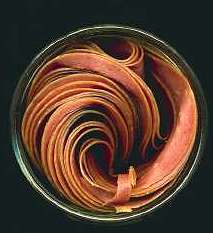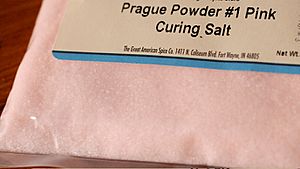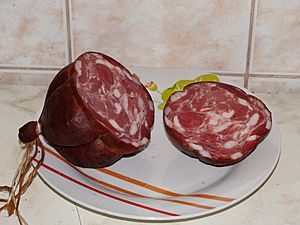Curing (food preservation) facts for kids

Curing is a way of preserving and flavoring foods like meat, fish, and vegetables. It involves adding things like salt, special chemicals called nitrates and nitrites, or sugar. These ingredients help to pull moisture out of the food, which stops it from spoiling. Many curing methods also include smoking, adding spices, or cooking.
Long ago, simply drying food was the first way people cured it. When you cure food, you make it harder for tiny germs to grow. These germs are what make food go bad. Curing has been used for thousands of years. It was the main way to keep meat and fish fresh until the late 1800s.
Nitrates and nitrites are often used with salt to cure meat. They are very good at stopping harmful bacteria, like Clostridium botulinum, from growing. They also help give cured meats their special pink color.
Meat preservation means all the ways we treat meat from animals, wild game, and poultry to keep it good. The goal is to keep its properties, taste, texture, and color. We want to make sure it stays safe to eat, whether it's raw, partly cooked, or fully cooked. Curing has been the main way to preserve meat for thousands of years. But now, new methods like refrigeration and man-made preservatives are also used.
In the past, curing meat was mostly about preventing disease and making sure there was enough food. Today, in many developed countries, curing is often done for its cultural value. People also love the special taste and texture it gives to food. For countries still developing, curing is still a very important way to keep meat good for transport and use.
Contents
Why Do We Need to Cure Food?

Fresh meat goes bad very quickly if it's not preserved. How fast it spoils depends on things like how humid the air is, the temperature, and if there are bad germs around. Most meats can't be kept at room temperature for more than a few days without spoiling.
If meat is kept too long, it starts to change color and smell bad. This means it's decomposing. Eating spoiled meat can make you very sick, sometimes with serious food poisoning.
When fresh meat was easy to get, its short shelf life wasn't a big problem. But during times of food shortage or long journeys, meat would spoil fast. So, it was very helpful to have ways to preserve food for travel and storage.
Curing helps meat last much longer before it spoils. It does this by making the environment difficult for spoilage germs to grow in.

Food curing has been around since ancient times. People used both smoked meat and salt-cured meat. Regular table salt is the main ingredient in curing meat. Sugar is also added to meat for curing, in many forms like honey or maple syrup. Except for bacon, sugar doesn't add much flavor. Instead, it helps to make the strong taste of the salt less harsh.
How Does Smoking Help Preserve Meat?
Meat can also be preserved by "smoking." This means exposing it to smoke from burning wood or other plant materials. If the smoke is hot enough, it can also slow-cook the meat, keeping it tender. One way to smoke meat is in a special smokehouse using damp wood chips or sawdust.
In North America, people often use hardwoods like hickory and maple for smoking. Wood from fruit trees like apple and cherry is also popular. Even corncobs can be used!
Smoking helps to seal the outside of the food. This makes it harder for bacteria to get inside. Smoking can be done along with other curing methods, like salting. Common smoking styles include hot smoking, smoke roasting (like barbecue), and cold smoking. Smoke roasting and hot smoking cook the meat, but cold smoking does not. If meat is cold smoked, it should be dried quickly. This stops bacteria from growing before the meat is fully dry. You can do this by slicing the meat thinly, like when making jerky.
How Curing Changed Food Trade
Better ways to preserve meat and transport it have changed how food is traded. Now, places that produce meat can be far away from where it's eaten. This makes it possible to export meats all over the world.
For example, in the 1980s, new ways to preserve meat using a special "controlled atmosphere" changed the global market for lamb. New Zealand, a big lamb exporter, could now sell its lamb as fresh meat. This is because it could be kept fresh for 12 to 16 weeks. This was enough time for it to reach Europe by boat. Before this, lamb from New Zealand had to be frozen, which made it less valuable in European stores.
Images for kids
-
Young man preparing a pig's head after a sacrifice. Vase from 360–340 BC, National Archaeological Museum of Spain.
-
Barrels of salt beef and other products in a reconstruction of an American Civil War stockpile, at Fort Macon State Park, North Carolina.
See also
 In Spanish: Curado para niños
In Spanish: Curado para niños





